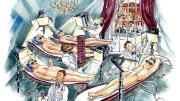1913
In response to a petition from the Woodrow Wilson Club of Harvard, a justice of the Supreme Judicial Court rules that college students may vote in Cambridge if they make the city their domicile, even though the parents who support them live elsewhere.
1928
The Harvard Club of Boston has introduced “the most novel of winter resorts”—a tanning salon. At 50 cents a sun bath, “over 300 men visit the beach regularly” to take their ease, clad only in goggles. Beginners are allowed two or three minutes a side; the “hardened” have 10 each way, and not a minute more.
1933
Lampoon editors sneak into the Crimson building and publish a spoof “extra” announcing the selection of “Henry E. Clarke ’04… a [nonexistent] business Messiah” as Harvard’s new president.
1958
For the first time in its history, the Harvard Fund Campaign has garnered more than a million dollars in a single year.
The Phillips Brooks House Association has officially merged with the Radcliffe Voluntary Service Organization, following the pathbreaking coeducational initiatives of the College’s United Nations Council and the Harvard Dramatic Club.
1963
On the Peace Corps’ second anniversary, the 43 College alumni serving abroad place Harvard second only to Berkeley as a source of A.B.s in the Corps.
1978
At its March and April meetings, the Faculty of Arts and Sciences discusses the proposed “Core Program,” described by its chief proponent, Dean Henry Rosovsky, as not going “back to basics—I detest that phrase—but forward to modern liberal education.”
1993
About 50 students from the newly formed Minority Coalition for Diversity make an unscheduled appearance during the College’s Junior Parents Weekend to denounce “Harvard’s failure to realize institutional diversity.”









